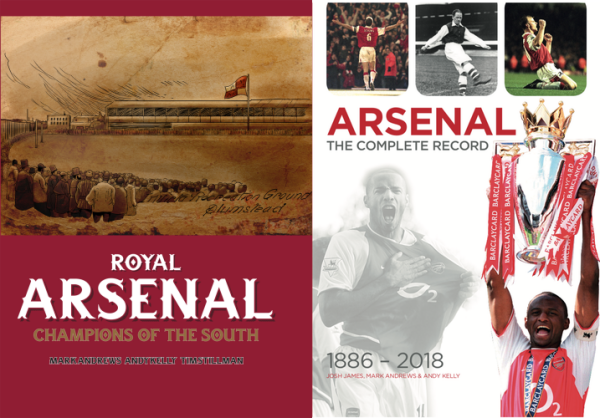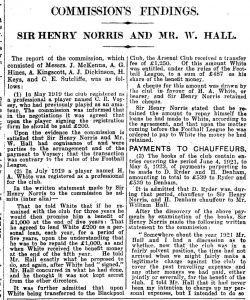But not when most people think
Sir Henry Norris. Depending on which team you support, Sir Henry was either Arsenal’s saviour or the scourge of Tottenham. Even to some Arsenal fans he is thought of as a villain. Many of the negative stories about Sir Henry have been shown to have been exaggerated or even fabricated. However, one fact that cannot be ignored is that he was banned from the game for life by the Football Association for a number of financial indiscretions.
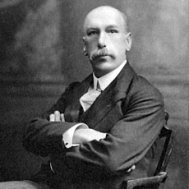
As we at The Arsenal History have discovered over the last few years, there is a major discrepancy in the facts of this story.
There’s no denying that Arsenal Chairman Sir Henry Norris was banned from football, having been found guilty of a number of financial irregularities. However, the timeline appears to have become skewed over the years, along with who had the authority to execute this decision.
The actual story is told in full in Sally Davis’ excellent website that chronicles the life of Norris (relevant links are at the very bottom of the page). The site is so comprehensive that many historians (and Arsenal-bashing fans) seem incapable of reading the whole story and digesting the facts, preferring to dip in and believe they have an understanding.
What we will do here is pull out the relevant facts and show what actually happened and when; using contemporary sources, not books using secondary sources written many years after the events.
The course of events relating to Norris’ ban date back to 1919 and came to a head in 1927.
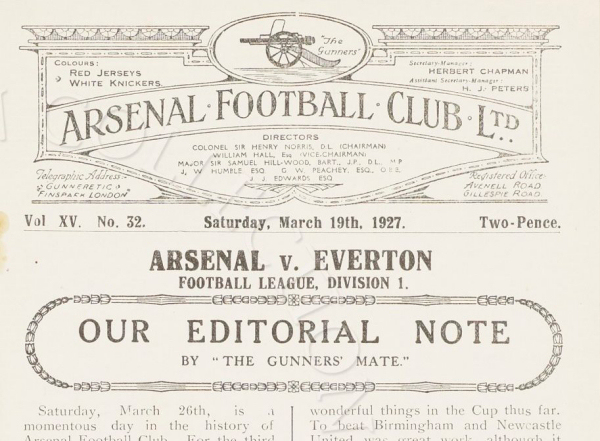
The calm before the storm
In February 1927, Norris’ fellow director William Hall was made aware that Norris had forged Herbert Chapman’s signature on a cheque that was used to buy the Arsenal reserve team bus. For some reason, the chairman of Fulham FC was aware of this and had threatened to take the matter to the Football Association to investigate. Hall told Norris that he should resign from Arsenal’s board of directors to prevent an enquiry into Arsenal’s affairs. Norris refused, and Hall resigned instead in late March.
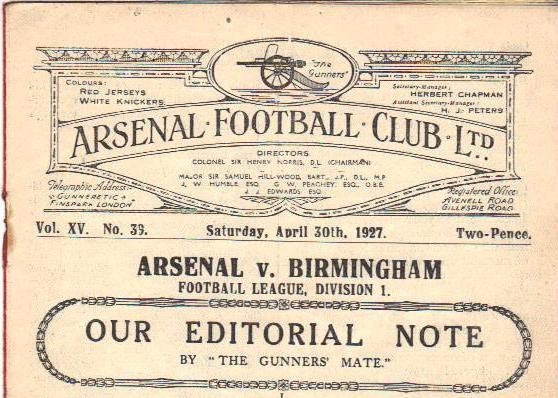
30 April 1927 Norris was chairman, Hall had resigned
Norris also issued writs against Fulham’s chairman and three other employees of the club. This action was his undoing as the Football League became alerted and wanted to know why two of its members were involved in a potential court case against each other, and why a senior director of one of these teams had resigned.
Having looked into the situation, Charles Sutcliffe, acting for the Football League, suggested that Norris should resign and that the Football League would not look any further into the club’s finances.
Norris resigned from Arsenal’s board of directors on 1 July 1927. However, the following day William Hall then made a formal application to the Football Association (a higher authority than the Football League) to look into Arsenal’s financial affairs.
Later that month the FA opened and adjourned an inquiry against Arsenal FC, who were charged with:
- the payment of a £200 signing-on fee to Clem Voysey in 1919
- when Henry Norris took £487 due to player Bert White as his financial cut of his transfer to Blackpool, he broke Foorball League rules
- the payment in 1925 of £143 legal costs incurred by Jock Rutherford
- although the FA Commission’s report didn’t actually say so, it implied that a cheque made out by Arsenal to Queensborough Motor Company – and what was done with the £170 cheque for the sale of the reserve team bus – had both broken FA Financial Rules 1 and 4
- the payment of travel expenses for Henry Norris in 1927; and the wages of both his and William Hall’s chauffeurs from 1921 to 1923.
The FA commission concluded their enquiry on 8 August and made a number of recommendations to the FA council which were acted upon later that month. But before the FA council acted, Henry Norris’ solicitors tried to have the results kept private so that they would not be published in the press. They failed, and this had further implications which have resulted in confusion.
The Daily Mail’s report on the commission’s findings are reproduced below. Click on each image to enlarge them.
.
.
.
.
.
.
.
.
.
.
.
.
.
.
.
.
.
.
.
.
.
On 29 August 1927 Sir Henry Norris and William Hall were suspended from football sine die. From this point onwards, Norris and Hall played no part in football management whatsoever. They were still shareholders but held quantities so small that they had no influence on the limited company. Hall sold his entire shareholding shortly afterwards but Norris held on to most of his until his death.
The masthead of the first matchday programme of the 1927-28 season confirmed that Norris and Hall were no longer directors of the club.
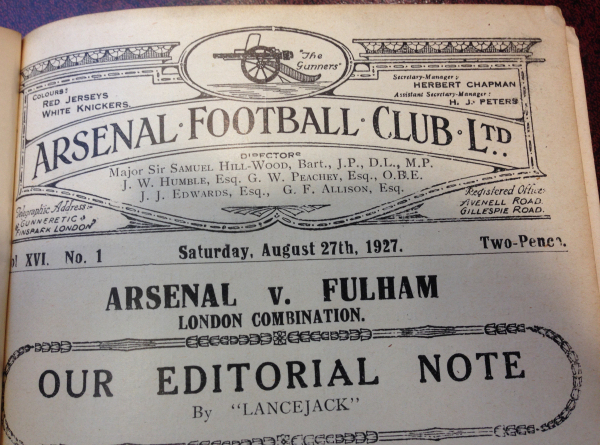
27 August – Norris had gone
Two days after this game, the FA commission’s findings were published. As a result, two more Arsenal directors were suspended by the FA. The two other casualties were Jack Humble and George Peachey.
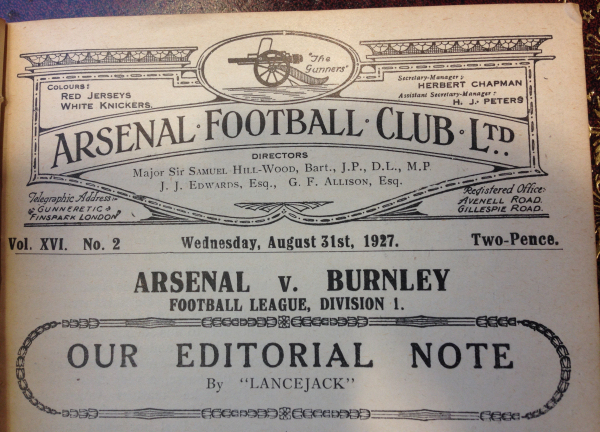
31 August 1927 – Humble and Peachey now gone
That should be the end of the story and the record books should have closed on the matter. But Norris wouldn’t let the matter lie and his actions over the next two years have caused a great deal of confusion to some historians.
He decided that he had a gripe with the Daily Mail and the Football Association. In so doing, he issued writs on:
- 15 September 1927 against the Daily Mail for publishing a report of the Arsenal Annual General Meeting which he said was a private affair amongst shareholders
- 6 October 1927 against the Football Association claiming that he had been libelled in the report of their enquiry
On 26 November 1928, Norris dropped his action against the Daily Mail.
On 5 February 1929 the libel case against the FA was heard in the High Court presided by the Lord Chief Justice (Lord Hewart). Norris lost this case as it was found in the FA’s favour. This is where the confusion arises. Many people believe that this was the point at which Norris was banned from football, but it wasn’t. He was banned by the FA back in August 1927. The libel case had no bearing on the FA’s decision. If Norris had won this case he still wouldn’t have been allowed back into the game: this was merely a simple libel case between two parties.
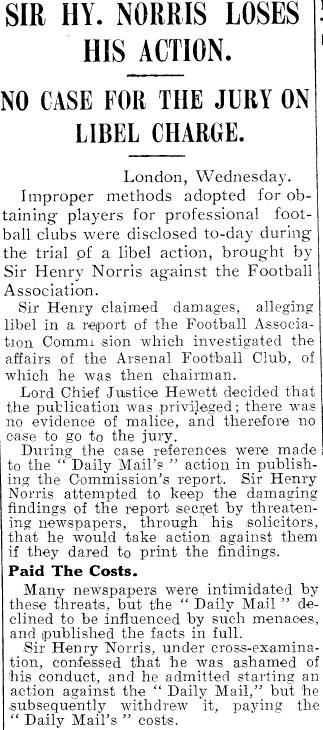
Daily Mail 7 February 1929
We believe that this decision to ban Norris also adds weight to the defence that he didn’t bribe, or offer a bribe to, anyone back in 1919 to get Arsenal elected to the First Division. If that had been the case, surely there would have been at least one person who would have spoken up at this point. The cast of characters involved in bringing down Norris was many and varied. They managed to dig up all sorts of dirt on him, but absolutely nothing relating to the election.
There is another fallacy in Arsenal’s history that has a tenuous connection to this story which will be told at a later date. The relevance here is the date, 29 August 1927, that Norris was suspended sine die by the FA.
Following Norris’ ban from football in 1927 it subsequently came to light that Charlie Roberts, Eric Shawn, Dick Fitzwell and Phil McCracken (all chairmen of Football League clubs in 1919) had accepted bribes from Norris to vote Arsenal into the First Division in 1919. However, as he was no longer involved in the game the FA were unable to take any further action against Norris. N.B. This last paragraph is completely fabricated to show how easy it is to cite a source on Wikipedia and for closed-minded people to believe whatever they want to suit their agenda. Charlie Roberts was Tottenham’s manager and the other three ‘chairmen’ are double entendres (erection, dick fits well and fill my crack in).
Background to this article
Following discussions with Steve Kell of the AFSC, Mark and I suggested writing for Gunflash for the 2015-16 season. Steve pointed out this would continue Gunflash’s tradition of publishing articles by guest writers, which makes it a great honour for us to be part of this great publication.
Current and back issues of Gunflash are available from the Arsenal Football Supporters Club on matchdays on the corner of Gillespie Road and St. Thomas’ Road, and via their website.
Special thanks to Paul Matz and Andy Exley for their help with sourcing some of the information.
—————–
Don’t forget to subscribe to the blog (top right). You know it makes sense.
Or have a look at our other site: The Arsenal Collection for more Arsenal memorabilia.
Copies of our books Royal Arsenal – Champions of the South and Arsenal: The Complete Record 1886-2018 are still available from the publishers.
